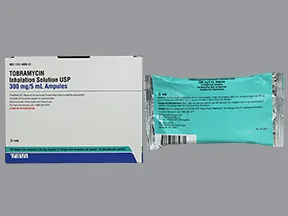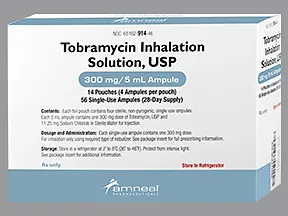Uses
This medication is used to treat people with a certain inherited condition (cystic fibrosis) who have an ongoing lung infection with a certain bacteria (Pseudomonas aeruginosa). People with cystic fibrosis produce thick, sticky mucus that can plug up the tubes, ducts and passageways in the lungs. This can result in serious breathing problems and infections in the lungs.Tobramycin belongs to a class of drugs known as aminoglycoside antibiotics. Tobramycin inhalation solution works by stopping the growth of a certain bacteria (Pseudomonas aeruginosa) that commonly infects the lungs of people with cystic fibrosis. This effect decreases lung infections and damage, and helps to improve breathing.
How to use Tobramycin Ampul For Nebulization
Read the Patient Information Leaflet if available from your pharmacist before you start using this medication and each time you get a refill. This medication is used with a special machine called a nebulizer that changes the solution to a fine mist that you inhale. Learn and follow all instructions for the use of this medication and the nebulizer. Children may need help from an adult to use this medication properly. If you have any questions, ask your doctor, pharmacist, or respiratory therapist.
Use this medication with the nebulizer as directed by your doctor, usually every 12 hours. Each treatment lasts about 15 minutes. This medicine is usually used for 28 days in a row, followed by 28 days without this medication, repeating the cycle until your doctor directs you to stop.
Each ampule of tobramycin is for one-time use. Inspect each ampule before use. Normal solution is slightly yellow and may darken with age. Discard the ampule if the solution is cloudy or has particles in it, or if it has expired or has been stored at room temperature for longer than 28 days. Use all of the contents of the ampule for each dose. Do not mix tobramycin with any other medicines in the nebulizer.
For the best effect, use this antibiotic at evenly spaced times. To help you remember, use this medication at the same time(s) every day.
Continue to take this medication until the full prescribed amount is finished, even if symptoms disappear after a few days. Stopping the medication too early may result in a return of the infection.
Tell your doctor if your condition does not improve or if it worsens.
Side Effects
Hoarseness and changes in voice may occur. If any of these effects last or get worse, tell your doctor or pharmacist promptly.
Remember that this medication has been prescribed because your doctor has judged that the benefit to you is greater than the risk of side effects. Many people using this medication do not have serious side effects.
Tell your doctor right away if you have any serious side effects, including: signs of hearing damage (such as ringing/roaring sounds in the ears, hearing loss, dizziness), signs of kidney problems (such as change in the amount of urine), chest tightness/wheezing.
A very serious allergic reaction to this drug is rare. However, get medical help right away if you notice any symptoms of a serious allergic reaction, including: rash, itching/swelling (especially of the face/tongue/throat), severe dizziness, trouble breathing.
This is not a complete list of possible side effects. If you notice other effects not listed above, contact your doctor or pharmacist.
In the US -
Call your doctor for medical advice about side effects. You may report side effects to FDA at 1-800-FDA-1088 or at www.fda.gov/medwatch.
In Canada - Call your doctor for medical advice about side effects. You may report side effects to Health Canada at 1-866-234-2345.
Precautions
Before using tobramycin inhalation solution, tell your doctor or pharmacist if you are allergic to it; or to other aminoglycoside antibiotics (such as gentamicin); or if you have any other allergies. This product may contain inactive ingredients, which can cause allergic reactions or other problems. Talk to your pharmacist for more details.
Before using this medication, tell your doctor or pharmacist your medical history, especially of: hearing problems (including deafness, decreased hearing), kidney problems, myasthenia gravis, Parkinson's disease.
Tobramycin may cause live bacterial vaccines (such as typhoid vaccine) to not work well. Tell your health care professional that you are using tobramycin before having any immunizations/vaccinations.
Before having surgery, tell your doctor or dentist about all the products you use (including prescription drugs, nonprescription drugs, and herbal products).
During pregnancy, this medication should be used only when clearly needed. It may harm an unborn baby. Discuss the risks and benefits with your doctor.
It is unknown if inhaled tobramycin passes into breast milk. Consult your doctor before breastfeeding.
Interactions
Drug interactions may change how your medications work or increase your risk for serious side effects. This document does not contain all possible drug interactions. Keep a list of all the products you use (including prescription/nonprescription drugs and herbal products) and share it with your doctor and pharmacist. Do not start, stop, or change the dosage of any medicines without your doctor's approval.
Other medications that may affect hearing may increase the risk of hearing loss if taken with tobramycin. Some affected drugs include: amikacin, gentamicin, mannitol, among others.
Overdose
If someone has overdosed and has serious symptoms such as passing out or trouble breathing, call 911. Otherwise, call a poison control center right away. US residents can call 1-800-222-1222. Canada residents can call 1-844-764-7669.
Do not share this medication with others.
Lab and/or medical tests (such as breathing tests, hearing tests, kidney function, tobramycin levels) may be done while you are using this medication. Keep all medical and lab appointments. Consult your doctor for more details.
If you miss a dose, use it as soon as you remember. If it is near the time of the next dose, skip the missed dose. Use your next dose at the regular time. Do not double the dose to catch up.
Store ampules in the refrigerator away from light. The ampules may also be stored at room temperature if needed. If the ampules are stored at room temperature, discard after 28 days. Keep all medications away from children and pets.
Do not flush medications down the toilet or pour them into a drain unless instructed to do so. Properly discard this product when it is expired, or no longer needed, or if it has been stored at room temperature for more than 28 days. Consult your pharmacist or local waste disposal company.
Images

tobramycin 300 mg/5 mL in 0.225 % sodium chloride for nebulization
Color: slightly yellowShape: Imprint:This medicine is a slightly yellow, clear, nebulizer soln

tobramycin 300 mg/5 mL in 0.225 % sodium chloride for nebulization
Color: slightly yellowShape: Imprint:This medicine is a slightly yellow, clear, nebulizer soln

tobramycin 300 mg/5 mL in 0.225 % sodium chloride for nebulization
Color: slightly yellowShape: Imprint:This medicine is a slightly yellow, clear, nebulizer soln

tobramycin 300 mg/5 mL in 0.225 % sodium chloride for nebulization
Color: slightly yellowShape: Imprint:This medicine is a slightly yellow, clear, nebulizer soln
You Might Also Like
Are you currently using Tobramycin Ampul For Nebulization?
This survey is being conducted by the WebMD marketing sciences department.
Selected from data included with permission and copyrighted by First Databank, Inc. This copyrighted material has been downloaded from a licensed data provider and is not for distribution, except as may be authorized by the applicable terms of use.
CONDITIONS OF USE: The information in this database is intended to supplement, not substitute for, the expertise and judgment of healthcare professionals. The information is not intended to cover all possible uses, directions, precautions, drug interactions or adverse effects, nor should it be construed to indicate that use of a particular drug is safe, appropriate or effective for you or anyone else. A healthcare professional should be consulted before taking any drug, changing any diet or commencing or discontinuing any course of treatment.